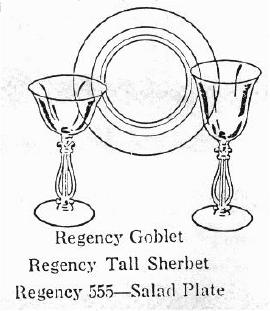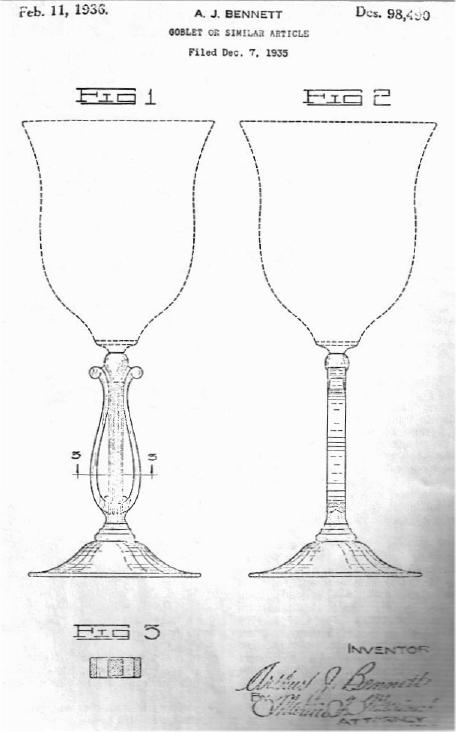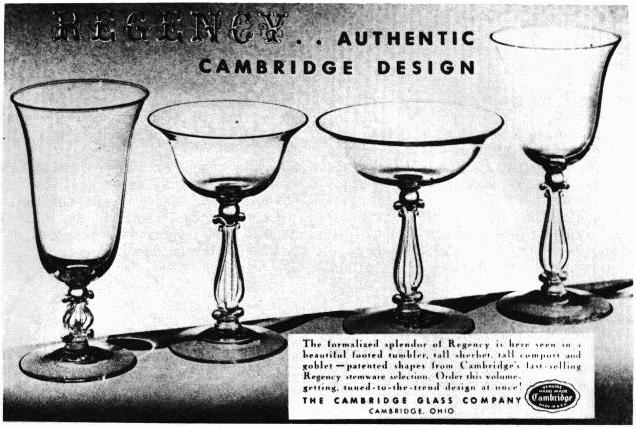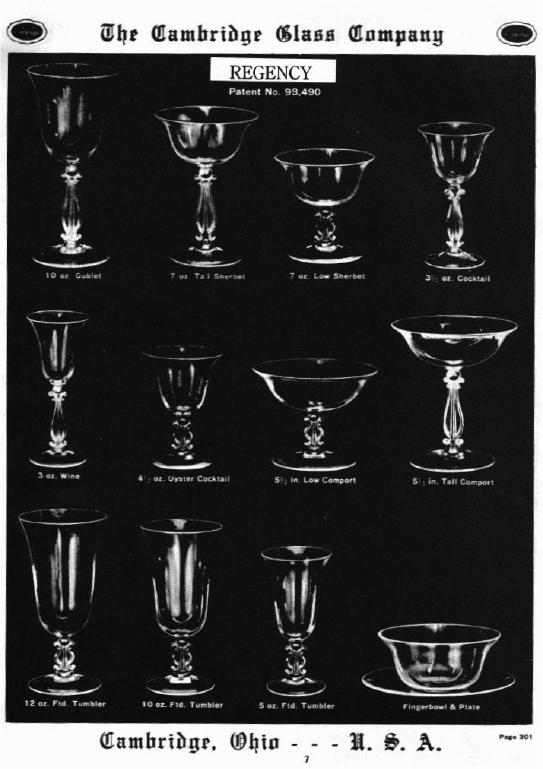Regency: Authentic Cambridge Design
by Mark A. Nye
Issue No. 214 - February 1991
Fifty years ago this month, the February 1941 issue of Crockery and Glass Journal carried the Cambridge advertisement for Regency stemware, shown at the end of this article.
The same illustration also appeared in the January 1941 issue as a photograph, (this may have been a news item rather than a paid advertisement) with the following caption:
"Selection of pieces from the new Regency line at Cambridge Glass Co. includes graceful goblet, saucer champagne, footed ice tea and comport. The lyre-like lines of the stem add to the charm."
Anyone not knowing the history of Cambridge and its stemware lines could easily assume from the preceding that Regency was a new stemware line. They would, of course, have made a wrong assumption since Regency stemware is nothing more than Stradivari stemware with a new name.
On December 7, 1935 a design patent application, serial number 59,950, for a goblet or similar article, with Arthur J. Bennett listed as the inventor, was filed with the United States Patent Office. Slightly over two months later, on February 11, 1936, 55 years ago this month, Design Patent No. 98,490 was issued to Mr. Bennett. The term of the patent was seven years. The bowl shape as sketched for the patent application is not the shape that was eventually used for the line. In addition, the stem itself was slightly altered prior to its production.
The oldest trade journal reference to the Stradivari line is dated February 1937, and the following month, appearing in China, Glass and Lamps, was a photograph of the goblet, tall sherbet and a plate with the following caption:
"The Stradivari stem shape showing the Celestial engraving from the Cambridge Glass Co. is illustrated below. This is brand new. A fine range of new engravings are now being shown on this shape."
Whether or not the line was in production during 1936 has yet to be determined.
The line consists of those items found in most Cambridge stemware lines dating to the 1930s and 1940s, namely: goblet, tall sherbet (saucer champagne), low sherbet, claret, cocktail, wine, oyster cocktail, cordial and three footed tumblers, 12, 10 and 5 oz. Also in the line were two comports, low and tall, both having a 5½" diameter.
 The etchings Diane and Portia were available on Stradivari blanks by
early 1938, and continued to be in the Cambridge line until some time
after 1940, as these combinations were available from the 1940 catalog.
The cuttings Celestial, Melody, Symphony and #940 were first used in
conjunction with the Stradivari line during 1937-38. None of these
cuttings, nor the Stradivari line, appear in the 1940 Cambridge Rock
Crystal catalog; indicating these combinations were dropped prior to
that year.
The etchings Diane and Portia were available on Stradivari blanks by
early 1938, and continued to be in the Cambridge line until some time
after 1940, as these combinations were available from the 1940 catalog.
The cuttings Celestial, Melody, Symphony and #940 were first used in
conjunction with the Stradivari line during 1937-38. None of these
cuttings, nor the Stradivari line, appear in the 1940 Cambridge Rock
Crystal catalog; indicating these combinations were dropped prior to
that year.
All decoration of the line was ceased during the 1940s. When the original June 1949 Cambridge catalog was issued, only the goblet was illustrated, but the complete line was available (plain only) and priced at $15 per dozen pieces. The line continued to be available during the reopen years and for a short time, through a special matching service, was available with the Melody and Celestial cuttings.
The cocktail and cordial were produced in what Cambridge called Harlequin sets during the early 1940s. These sets were composed of one each of the item in eight different colors. These colors were: tahoe blue; moonlight; forest green; gold; rosa; mocha; pistachio and amethyst. Due to wartime shortages, these sets were discontinued in October 1943.
As mentioned earlier, the original name for this line was Stradivari and its line number was #3575, though it was seldom used, even by Cambridge. The Stradivari was used in the 1940 Cambridge catalog and price lists, but a supplemental page (probably issued in 1941) uses the name Regency. Copies of the 1940 catalog, with the name Regency pasted over the Stradivari name, are in existence. The date for the name change is also confirmed by the trade journal advertisements that were cited at the beginning of this article.
Why the change in names from Stradivari to Regency? We may never know the complete story, but one theory is salesmen were having trouble spelling Stradivari. By 1941 we were at war with Italy and perhaps this had some bearing on the change.
Other than the cordials and cocktails made for Harlequin sets, Stradivari/Regency was not produced in color and has a non-optic bowl.



